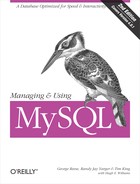MySQL Data Types
In a table, each
column has a type. As we mentioned earlier, an SQL data type is
similar to a data type in traditional programming languages. While
many languages define a bare-minimum set of types necessary for
completeness, SQL goes out of its way to provide types such as
DATE that will be useful to everyday users. You
could store a DATE type in a more basic numeric
type, but having a type specifically dedicated to the nuances of date
processing adds to SQL’s ease of use—one of
SQL’s primary goals.
Chapter 16 provides a full reference of SQL types supported by MySQL. Table 3-1 is an abbreviated listing of the most common types.
MySQL supports the
UNSIGNED
attribute for all numeric types. This
modifier forces the column to accept only positive (unsigned)
numbers. Unsigned fields have an upper limit that is double that of
their signed counterparts. For instance, an unsigned
TINYINT—MySQL’s single-byte
numeric type—has a range of 0 to 255 instead of the -128 to 127
range of its signed counterpart.
MySQL provides more types than those mentioned in Table 3-1. In day-to-day programming, however, you will use these types most often. The size of the data you wish to store plays a large role in the design of your MySQL tables.
